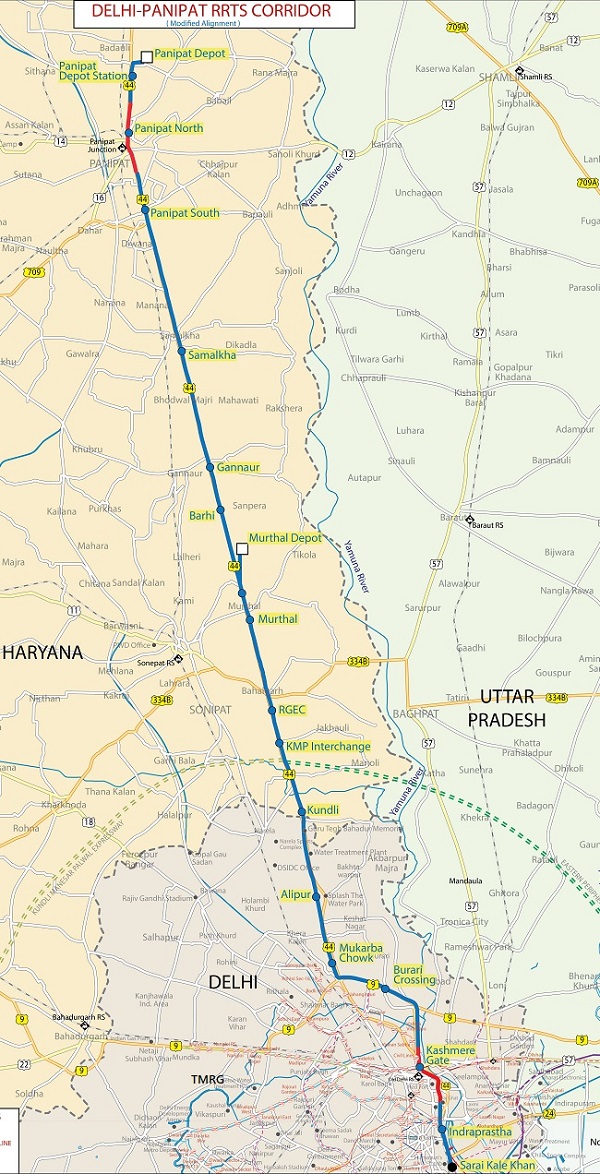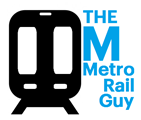Delhi – Panipat RRTS Approved by Haryana Government’s Cabinet
Haryana state government’s cabinet on Wednesday approved the detailed project report (DPR) for the new 103.02 km Delhi – Panipat Regional Rapid Transit System (RRTS) line which will consist of 17 stations of which 11 will be located in Haryana.
This line is one of the three early bird (Phase 1) lines to be developed by the National Capital Region Transport Corporation (NCRTC) where trains – just like those on the Delhi-Meerut and Delhi-Alwar lines – will run up to a maximum speed of 160 km/hr to cover the entire distance in 1 hour.
This line is estimated to cost Rs. 21,627 crore, and out of that Haryana Government will contribute Rs 4,699 as the state’s share. Per the government’s press release, construction of this line will be carried out in two stages – from Sarai Kale Khan to Murthal (58.28 km) and Murthal to Panipat (44.74 km).
The 17 stations on this line will be located at Nizamuddin / Sarai Kale Khan (under construction as part of the Delhi-Meerut RRTS line), Indraprastha, Kashmere Gate, Burari Crossing, Mukarba Chowk, Alipur, Kundli, KMP Expressway Interchange, Rajeev Gandhi Edication City (RGEU), Murthal, Barhi, Gannaur, Samalkha, Panipat South, Panipat North, Panipat Depot.

Route shown in red will be underground. Rest will be elevated. In the future, this RRTS line is planned to be extended by 25 kms to Karnal with 3 new stations at Gharunda, Madhuban and Karnal.
The line’s DPR is currently awaiting the Delhi Government’s approval. After that happens, it will be sent to the Central Government for its cabinet’s approval.
With this exciting development, I expect NCRTC will soon start inviting tenders for geotechnical investigation, pile load tests, Detailed Design Consultancy (DDC) and General Consultants (GC) services. Ground work for civil construction is expected to start no sooner than mid-2022.
For more updates, check out the NCR RRTS section of The Metro Rail Guy!
– TMRG




Nice to see. But the question is if this RRTS will built, then where the Delhi-Amritsar HSR will built. This will create space constraints?
Good question. Recent HSR tenders show the line taking a more north-westerly greenfield route. Look up Kaithal in Haryana – it is planned to pass right by it.
Does enough traffic exists to justify need of RRTS on this route?
Route between Delhi – Murthal is heavily built-up on either side. Even though things thin out heading northward, IMO passenger loads will still be high.
There is a big big requirement of this. There is huge population going to murthal on a daily basis for paranthas, Panipat and kundli industrial area gets a lot of people and then there are a lot of people who travel to Delhi for their jobs.
I wish RRTS is built between Kolkata and Bardhaman…my home town
makes sense. this route us densely packed and is served by haryana roadways only rn
will find many takers.
also the extension to karnal (CM’s city) will probably have four stations ie gharaunda, madhuban, karnal south and karnal north.
karnal north can possibly be on new bus stand due to ample space and connections to yamunanagar, kaiithal and every other city thru haryana roadways
Rather than spending huge money on this project maintain the existing network improve the quality of construction
Thank you sir for your very helpful suggestion. May I suggest we should also scrap high speed and semi-high speed rail corridors and be content with a sub-urban rail network of very high average speed of 25 kmph ?
The stretch from Mukarba Chowk to Panipat is remarkably interesting – as it falls within the densely populated NCR and is almost a straight alignment, if routed along NH-44/GT Road (NH-1 as per old nomenclature).
I would like to see the planners of NCRTC & NHSRCL sit together, ponder their brains over and optimize the design of viaduct for RRTS & HSR lines. Some possible options could be:
1 – Common foundation / pier design – two level viaducts (RRTS on L1, HSR on L2);
2 – Common foundation / pier design – Single wide viaduct (all four lines on the same level) – It’s akin to a wide 4-lane flyover. However, Rail engineers need to ascertain technical viability of such an arrangement, especially for the cross-over lines (which may become quite problematic) and the stations;
3 – Combination of option-1 & 2 with occasional diversions/conversions at the entry/exit of dense settlements.
Land surface area is the biggest commodity in any urban/infra planning. For a densely populated country like India, land utilization must be optimized to the extent possible and ‘best in class’ technology & solutions shall be adopted. For this particular stretch (Mukarba chowk to Panipat), the RoW for National Highway is quite wide, which, I believe, can accommodate both the HSR & RRTS lines. I’ve a sense that – with common pier foundation, the design can be greatly optimized, and the costs can be considerably reduced (by many thousand crores, I believe). Let the planners/designers/estimators work it out. Lately, we are witnessing enough ‘political will’ to take-up such mega projects – we can’t blame the political/ruling class anymore – it’s all a technocrat’s job now; NCRTC/NHSRCL need to deliver…
Interesting suggestions. Hope they can achieve this integration. Engineering would be able to do this, only the willingness to work across two agencies would be the block. We have never been good team players.
@TMRG : Is it possible to use common tracks for RRTS and HSR for cost savings.
Since they are yet to be built, pre-planning can be done for efficient construction and utilization of viaducts & tracks.
it is really a good transport system, that will certainly help in Delhi -NCR traffic movement
Also generate lots of job opportunities in the market and helping in boosting our economy
When is the RRTS expected to be functional? when is the construction work going to start?